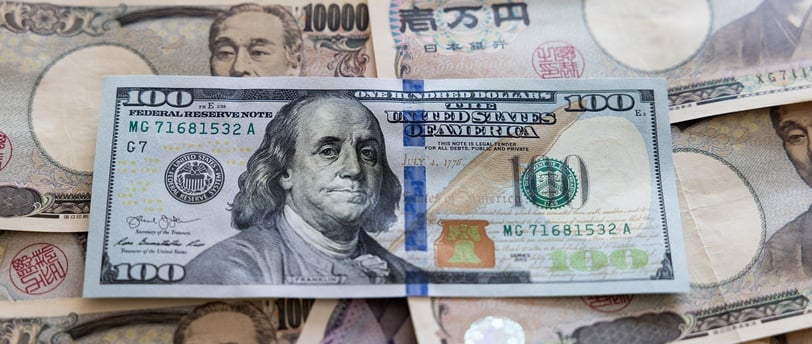Add your promotional text...
Asian Currencies Under Pressure: Dollar Strength and Economic Dynamics in Focus
Synopsis: Most Asian currencies faced a downturn on Monday as a robust U.S. dollar, fueled by stronger-than-expected payroll data, weighed heavily on the region. Despite positive trade data from China and interventions by the People’s Bank of China (PBOC), the yuan and other regional currencies struggled. Meanwhile, the market anticipates further cues on interest rates with upcoming U.S. inflation data and Federal Reserve signals.
FOREX
By Sonal Chauhan
1/13/20253 min read


The Week Begins with Dollar Dominance
Asian currencies commenced the week on a subdued note, grappling with the persistent strength of the U.S. dollar. A combination of robust U.S. economic data and muted regional trading activity due to a Japanese holiday left currencies across Asia under pressure. Despite pockets of positive developments, such as encouraging Chinese trade figures, regional currencies failed to gain momentum.
The Dollar’s Resurgence: A Force to Reckon With
The U.S. dollar soared to a 24-month high, driven by unexpectedly strong nonfarm payroll data. This development reinforced the Federal Reserve's cautious approach to monetary easing in 2025.
Key Drivers of Dollar Strength:
Labor Market Resilience: December’s payroll data exceeded expectations, underscoring the robustness of the U.S. labor market.
Sticky Inflation Concerns: Policymakers remain wary of persistent inflation, delaying aggressive rate cuts.
Fed’s Revised Outlook: Goldman Sachs analysts now forecast only two rate cuts in 2025, reflecting a higher terminal rate than previously anticipated.
With the consumer price index (CPI) inflation data set for release on Wednesday, investors are keenly awaiting further clues on the Federal Reserve’s monetary strategy.
Chinese Yuan: Struggling Amid Mixed Signals
Despite a surprising uptick in China’s trade balance for December, the yuan continued to face challenges. The USDCNY pair rose by 0.3%, reflecting ongoing investor caution.
Trade Data Insights:
China’s trade balance growth was bolstered by exporters rushing shipments ahead of U.S. President-elect Donald Trump’s planned tariffs.
While the figures appeared positive, they were viewed as a temporary response rather than an indicator of sustained growth.
PBOC Interventions:
The People’s Bank of China introduced measures to stabilize the yuan, including strong midpoint fixes and pausing bond-buying liquidity programs. However, these efforts yielded limited results, highlighting the need for more comprehensive stimulus measures from Beijing.
Broader Asian Currencies: Under Pressure
Across the region, Asian currencies traded in a flat-to-low range, overshadowed by the Federal Reserve’s stance on interest rates.
Currency Movements in Focus:
Japanese Yen (USDJPY): Fell 0.1%, weighed down by speculation over the Bank of Japan’s upcoming policy meeting.
Australian Dollar (AUDUSD): Rose slightly by 0.1% after touching a near five-year low the previous week.
South Korean Won (USDKRW): Marginal declines continued as traders remained cautious.
Singapore Dollar (USDSGD): Gained 0.1%, reflecting relative stability amid broader pressures.
Indian Rupee (USDINR): Stabilized after reaching record lows above 86 per U.S. dollar.
Geopolitical Tensions and Their Economic Impact
The impending inauguration of President-elect Donald Trump is adding uncertainty to the global economic landscape. Trump’s promise to impose steep tariffs on China from “day one” of his presidency has further complicated the outlook for the yuan and other regional currencies.
Potential Implications:
Export Dynamics: Tariffs could disrupt trade flows, impacting export-driven economies in Asia.
Policy Adjustments: Countries may need to recalibrate their monetary and fiscal policies to mitigate potential shocks.
Looking Ahead: Key Factors to Watch
As markets navigate the current dynamics, several key developments are poised to shape the trajectory of Asian currencies:
U.S. Inflation Data: The CPI report on Wednesday will provide critical insights into the Federal Reserve’s rate policy.
Fed Speeches: A series of addresses by Federal Reserve officials this week could influence market sentiment.
Bank of Japan Meeting: Policy signals from the Bank of Japan may affect the yen’s stability.
Chinese Stimulus Measures: Expectations are mounting for additional stimulus from Beijing to counter external pressures.
Navigating Uncertain Waters
The interplay between a robust U.S. dollar and regional economic challenges continues to exert pressure on Asian currencies. While countries like China are employing targeted interventions, broader macroeconomic trends, including U.S. interest rate policies and geopolitical tensions, are shaping the landscape.
For investors and policymakers, the current environment underscores the importance of vigilance and adaptability. As markets evolve, the resilience of Asian economies and their ability to navigate these headwinds will determine the region’s economic trajectory in the months ahead.
With critical data releases and policy decisions on the horizon, all eyes remain on the factors that will define the future of currency markets in Asia.
